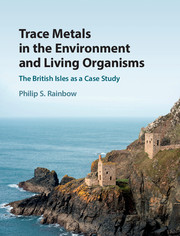Book contents
- Trace Metals in the Environment and Living Organisms
- Trace Metals in the Environment and Living Organisms
- Copyright page
- Contents
- Preface
- Acknowledgements
- 1 Introduction
- 2 Metals and Mining
- 3 Biology of Trace Metals
- 4 Terrestrial Environment
- 5 Freshwater
- 6 Estuaries
- 7 Coastal Seas and Oceans
- 8 Epilogue
- References
- Index
- Plate Section (PDF Only)
- References
References
Published online by Cambridge University Press: 23 August 2018
- Trace Metals in the Environment and Living Organisms
- Trace Metals in the Environment and Living Organisms
- Copyright page
- Contents
- Preface
- Acknowledgements
- 1 Introduction
- 2 Metals and Mining
- 3 Biology of Trace Metals
- 4 Terrestrial Environment
- 5 Freshwater
- 6 Estuaries
- 7 Coastal Seas and Oceans
- 8 Epilogue
- References
- Index
- Plate Section (PDF Only)
- References
- Type
- Chapter
- Information
- Trace Metals in the Environment and Living OrganismsThe British Isles as a Case Study, pp. 671 - 719Publisher: Cambridge University PressPrint publication year: 2018



